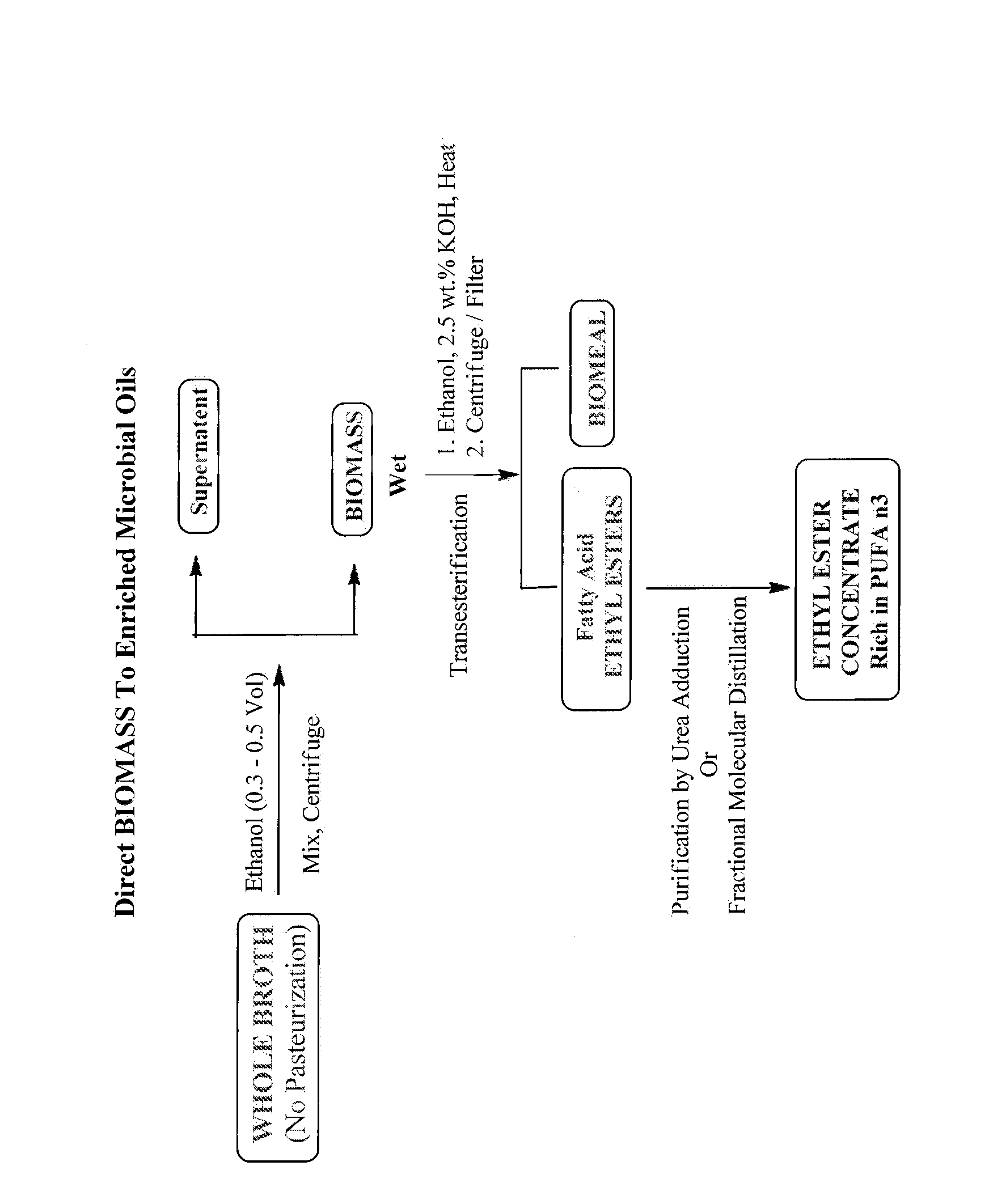Microbial oils enriched in polyunsaturated fatty acids
a technology of polyunsaturated fatty acids and microorganisms, applied in the field of microorganism oils, can solve the problems of fish oil carrying the risk of environmental contaminants, fishy odor or taste, slow metabolic conversion rate,
- Summary
- Abstract
- Description
- Claims
- Application Information
AI Technical Summary
Benefits of technology
Problems solved by technology
Method used
Image
Examples
example 1
Isolation of Microorganisms
[0246]Samples were collected from intertidal habitats during low tide, including bays and estuaries along the West Coast of North America (California, Oregon, and Washington) and Hawaii. Water, sediment, living plant material, and decaying plant / animal debris were placed into sterile 50 ml tubes. Portions of each sample along with the water were spread onto solid agar plates of isolation media. Isolation media consisted of: 500 ml of artificial seawater, 500 ml of distilled water, 1 g of glucose, 1 g of glycerol, 13 g of agar, 1 g of glutamate, 0.5 g of yeast extract, 0.5 g casein hydrolysate, 1 ml of a vitamin solution (100 mg / L thiamine, 0.5 mg / L biotin, 0.5 mg B12), 1 ml of a trace mineral solution (PII metals, containing per liter: 6.0 g FeCl36H2O, 6.84 g H3BO3, 0.86 g MnCl24H2O, 0.06 g ZnCl2, 0.026 CoCl26H2O, 0.052 g NiSO4H2O, 0.002 g CuSO45H2O and 0.005 g Na2MoO42H2O), and 500 mg each of penicillin G and streptomycin sulfate. The agar plates were inc...
example 2
Growth Characteristics of the Isolated Microorganism Deposited Under ATCC Accession No. PTA-10212
[0259]The isolated microorganism deposited under ATCC Accession No. PTA-10212 was examined for growth characteristics in individual fermentation runs, as described below. Typical media and cultivation conditions are shown in Table 1.
[0260]In carbon (glycerol) and nitrogen-fed cultures with 1000 ppm Cl− at 22.5° C. with 20% dissolved oxygen at pH 7.3, PTA-10212 produced a dry cell weight of 26.2 g / L after 138 hours of culture in a 10 L fermentor volume. The lipid yield was 7.9 g / L; the omega-3 yield was 5.3 g / L; the EPA yield was 3.3 g / L; and the DHA yield was 1.8 g / L. The fatty acid content was 30.3% by weight; the EPA content was 41.4% of fatty acid methyl esters (FAME); and the DHA content was 26.2% of FAME. The lipid productivity was 1.38 g / L / day, and the omega-3 productivity was 0.92 g / L / day under these conditions, with 0.57 g / L / day EPA productivity and 0.31 g / L / day DHA productivity....
example 3
Fatty Acid Profiles of Microorganism Strains ATCC PTA-10208 and PTA-10212
[0270]Four samples of biomass (PTA-10208 Sample #1; PTA-10208 Sample #2; PTA-10212 Sample #1; and PTA-10212 Sample #2) were analyzed for total crude oil content by solvent extraction, lipid classes were determined by high performance liquid chromatography / evaporative light scattering detection (HPLC / ELSD), triacylglycerol (TAG) were analyzed by HPLC / mass spectrometry (HPLC / MS), and fatty acid (FA) profiles were determined by gas chromatography with flame ionization detection (GC-FID). The crude lipid content of each freeze dried biomass was determined using solvent grinding with hexane and compared to the sum of FAME (mg / g) generated by direct transesterification, and the resultant fatty acid methyl esters (FAME) were quantified by GC / FID analysis. Fatty acids in the extracted crude lipid were also quantified by transesterification and quantified using GC / FID analysis of the resultant FAME. The weight percent o...
PUM
| Property | Measurement | Unit |
|---|---|---|
| Percent by mass | aaaaa | aaaaa |
| Percent by mass | aaaaa | aaaaa |
| Percent by mass | aaaaa | aaaaa |
Abstract
Description
Claims
Application Information
 Login to View More
Login to View More - R&D
- Intellectual Property
- Life Sciences
- Materials
- Tech Scout
- Unparalleled Data Quality
- Higher Quality Content
- 60% Fewer Hallucinations
Browse by: Latest US Patents, China's latest patents, Technical Efficacy Thesaurus, Application Domain, Technology Topic, Popular Technical Reports.
© 2025 PatSnap. All rights reserved.Legal|Privacy policy|Modern Slavery Act Transparency Statement|Sitemap|About US| Contact US: help@patsnap.com

